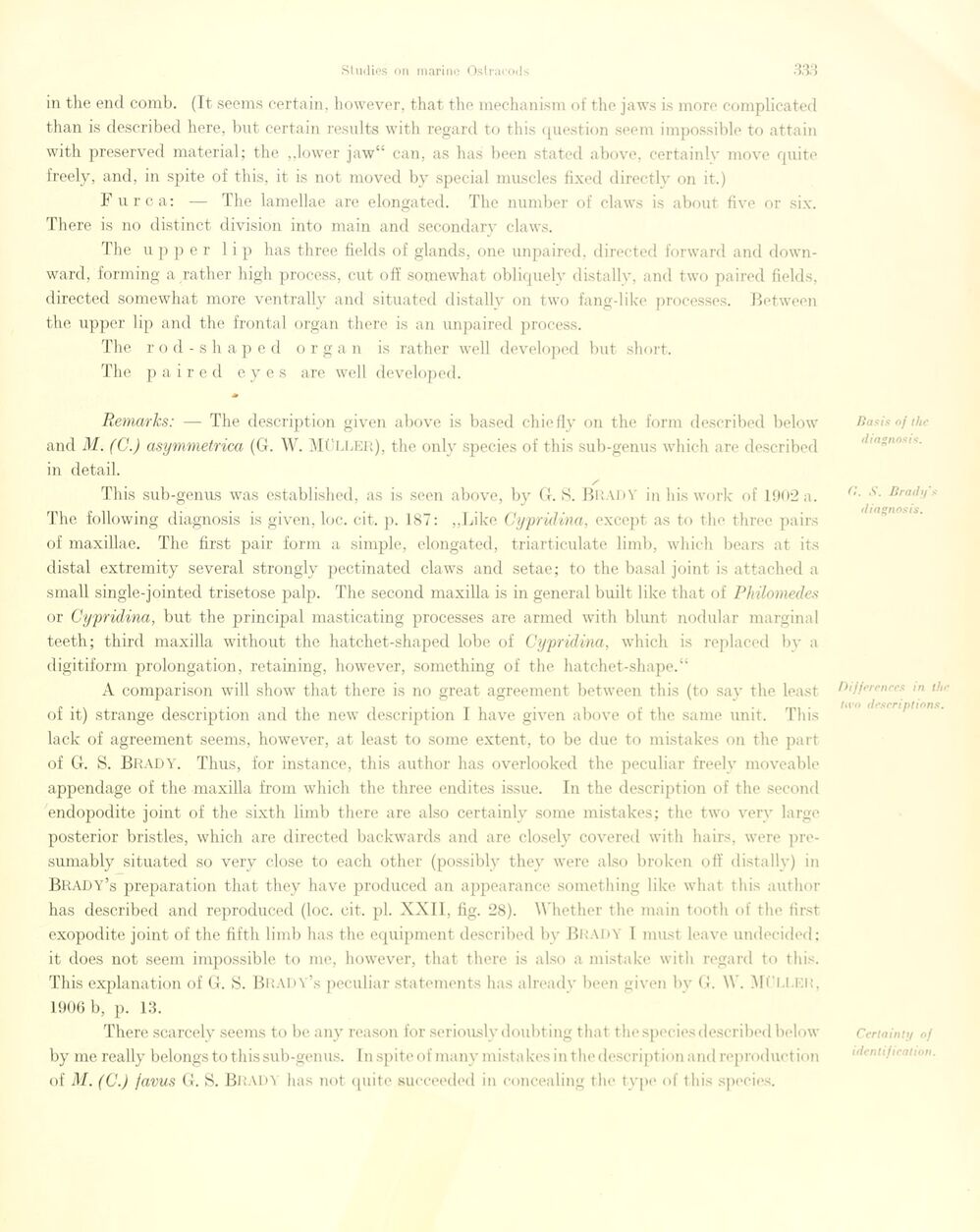
Full resolution (JPEG) - On this page / på denna sida - Sidor ...

<< prev. page << föreg. sida << >> nästa sida >> next page >>
Below is the raw OCR text
from the above scanned image.
Do you see an error? Proofread the page now!
Här nedan syns maskintolkade texten från faksimilbilden ovan.
Ser du något fel? Korrekturläs sidan nu!
This page has never been proofread. / Denna sida har aldrig korrekturlästs.
in the end comb. (It seèms certain, however, that tbe mechanism of the jaws is more complicated
than is described liere, but certain results with regard to this question seem impossible to attain
with preserved material; the „lower jaw“ can, as has been stated above, certainly move quite
freely, and, in spite of this, it is not moved by special muscles fixed directly on it.)
Furca: — The lamellae are elongated. The number of claws is about five or six.
There is no distinet division into main and secondary claws.
The ii p p e r 1 i p has three helds of glands, one unpaired, directed forward and
down-ward, forming a rather high process, cut off somewhat obliquely distally, and two paired helds,
directed somewhat more ventrally and situated distally on two fang-like processes. Between
the upper lip and the frontal organ there is an unpaired process.
The r o d - s h a p e d organ is rather well developed but short.
The paired e y e s are well developed.
Remarks: — The description given above is based chie hy on the form described below
and M. (C.) asymmetnea (G. W. MÜLLER), the only species of this sub-genus which are described
in detail.
/
This sub-genus was established, as is seen above, by G. S. BRADY inhiswork of 1902 a.
The following diagnosis is given, loc. cit. p. 187: „Like Cypridina, except as to the three pairs
of maxillae. The hrst pair form a simple, elongatecl, triartieulate limb, which bears at its
distal extremity several strongly pectinated claws and setae; to the basal joint is attached a
small single-jointed trisetose palp. The second maxilla is in general built like that of Philomedes
or Cypridina, but the principal masticating processes are armed with blunt nodular marginal
teeth; third maxilla without the hatchet-shaped lobe of Cypridina, which is replaced by a
digitiform prolongation, retaining, however, something of the hatchet-shape.“
A comparison will show that there is no great agreement between this (to sav the least
of it) strange description and the new description I have given above of the same unit. This
lack of agreement seems, however, at least to some extent, to be due to mistakes on the part
of G. S. BRADY. Thus, for instance, this author has overlooked the peculiar freely moveable
appendage of the maxilla from which the three endites issue. In the description of the second
endopodite joint of the sixth limb there are also certainly some mistakes; the two very large
posterior bristles, which are directed backwards and are closely covered with hairs. were
pre-sumably situated so very close to eacli other (possible they were also broken oft’ distally) in
BradY’s préparation that they have produced an appearance something like what this author
has described and reproduced (loc. cit. pl. XXII, fig. 28). Whether the main tooth of the first
exopodite joint of the fifth limb has the equipment described by Brady I must leave undecided:
it does not seem impossible to me, however, that there is also a mistake with regard to this.
This explanation of G. S. Brady’s peculiar statements has alreadv been given by G. \Y. MOLLER,
1906 b, p. 13.
There scarcely seems to be any reason for seriously doubting that the species described below
by me really belongs to this sub-genus. In spite of many mistakes in the descript ion and reproduction
of M. (C.) favus G. S. Brady has not quite succeeded in concealing the type of this species.
Basis of tlie
diagnosis.
C. S. Bratly’s
diagnosis.
Differences in the
Hvo descriptions.
Certainly of
identification.
<< prev. page << föreg. sida << >> nästa sida >> next page >>